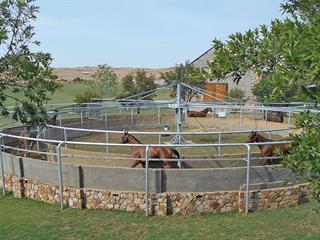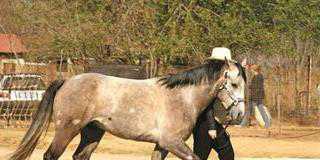
Horse walkers have been used for many years to exercise horses or cool them down after training (the so-called hot walker). They are based on the old horse-powered mill, where one to four horses were hitched to poles and driven in a circle round a central axis to grind flour.
The term ‘hot walker’ was originally coined to describe a groom employed to walk a horse after a race in order to cool it down. The groom would lead a horse slowly in circles, often pausing to sponge off sweat, until the horse was dry.
Trainers who had to exercise many young racehorses eventually realised that a mechanical device could walk four horses dry at the same time. Early models consisted of four metal arms radiating from a central pivot. Horses wore halters tied by lead ropes to each arm and it was important that if two horses were exercised they were tied to opposite sides of the machine.
Later, paddles were installed behind the horses and an external ring fence used, so that horses did not need to be tied up. The horse could only walk or trot.
Hot walkers are used throughout the world to exercise horses at a walk and trot. They save time and reduce the number and size of paddocks needed in a training establishment or quarantine station. Instead of a horse being let loose in a large paddock to exercise itself, it can be kept stabled or put outside in a 3m x 4m holding pen and given 40-minute exercise per day with other horses.
A further advantage of a hot walker is that fewer injuries occur when strange horses are put out together or try to escape from an unfamiliar paddock.
In Europe, trainers employ hot walkers for conditioning and rehabilitating horses used for racing, jumping and dressage; in the US, they are also used for reining and Western performance horses.
Programmable
Since about 2008, the electronically controlled, programmable horse exerciser has taken the concept to a new level. Indeed this device has become essential to professional trainers in racing and endurance riding. These new horse exercisers have seen the speed increased to 18km/h. This means that horses do not just walk or trot, they can canter too. They can also be turned around and exercised in the opposite direction, without taking them out of the machine.
The program can be adjusted for a group of horses, according to their age and stage of training. Using a programmable horse exerciser in addition to interval training under saddle builds muscles, endurance and ultimately speed in a scientific, measurable way.













